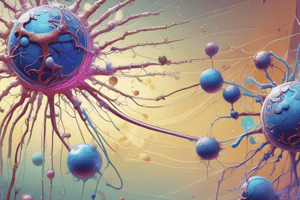Podcast
Questions and Answers
What is the primary purpose of immune tolerance?
What is the primary purpose of immune tolerance?
- To prevent the immune system from attacking the body's own tissues. (correct)
- To promote autoimmune reactions for immune system training.
- To enhance the immune response to self-antigens.
- To eliminate all foreign antigens from the body.
Which of the following is a characteristic of autoimmune diseases?
Which of the following is a characteristic of autoimmune diseases?
- Enhanced ability to distinguish between self and non-self antigens.
- Increased tolerance to self-antigens.
- Reduced immune response to pathogens.
- Tissue damage caused by the immune system. (correct)
What is the primary role of negative selection in the context of T-cell development?
What is the primary role of negative selection in the context of T-cell development?
- To convert T-cells into B-cells.
- To eliminate T-cells that strongly react to self-antigens. (correct)
- To enhance the ability of T-cells to respond to foreign antigens.
- To promote the survival of T-cells that recognize self-antigens.
Where does central tolerance primarily occur?
Where does central tolerance primarily occur?
Which of the following best describes peripheral tolerance?
Which of the following best describes peripheral tolerance?
What is clonal deletion?
What is clonal deletion?
In the context of T-cell maturation, what does positive selection refer to?
In the context of T-cell maturation, what does positive selection refer to?
Which of the following is an example of an immunoprivileged site?
Which of the following is an example of an immunoprivileged site?
What might happen if antigens that were previously 'ignored' due to immunoprivilege are suddenly exposed to the immune system?
What might happen if antigens that were previously 'ignored' due to immunoprivilege are suddenly exposed to the immune system?
What is the mechanism of action of Regulatory T cells (Treg cells) in maintaining peripheral tolerance?
What is the mechanism of action of Regulatory T cells (Treg cells) in maintaining peripheral tolerance?
In the context of peripheral tolerance, what is anergy?
In the context of peripheral tolerance, what is anergy?
How does the Fas-FasL interaction contribute to peripheral tolerance?
How does the Fas-FasL interaction contribute to peripheral tolerance?
What is the significance of IgM in the context of B cell central tolerance?
What is the significance of IgM in the context of B cell central tolerance?
Which of the following processes describes receptor editing in B cells?
Which of the following processes describes receptor editing in B cells?
What is the role of stromal cells in B cell central tolerance?
What is the role of stromal cells in B cell central tolerance?
If central tolerance is imperfect, what is the backup mechanism to prevent autoimmunity?
If central tolerance is imperfect, what is the backup mechanism to prevent autoimmunity?
How is 'ignorance' classified as a type of peripheral tolerance?
How is 'ignorance' classified as a type of peripheral tolerance?
What is the immediate consequence of a T cell binding to a 'self' antigen without adequate co-stimulation?
What is the immediate consequence of a T cell binding to a 'self' antigen without adequate co-stimulation?
Which cytokine is most associated with the suppressive function of T regulatory cells?
Which cytokine is most associated with the suppressive function of T regulatory cells?
What is the role of Fas ligand (FasL) in clonal deletion?
What is the role of Fas ligand (FasL) in clonal deletion?
Flashcards
What is immune tolerance?
What is immune tolerance?
The capability of the immune system to recognize and not attack self antigens.
What is Autoimmunity?
What is Autoimmunity?
Immune responses directed against the body's own tissues, resulting in damage.
What is Central Tolerance?
What is Central Tolerance?
Tolerance developed during lymphocyte development in the thymus (T cells) and bone marrow (B cells).
What is Peripheral Tolerance?
What is Peripheral Tolerance?
Signup and view all the flashcards
What is Clonal Deletion?
What is Clonal Deletion?
Signup and view all the flashcards
What are Immunoprivileged sites?
What are Immunoprivileged sites?
Signup and view all the flashcards
What is Anergy?
What is Anergy?
Signup and view all the flashcards
What are Regulatory T-cells?
What are Regulatory T-cells?
Signup and view all the flashcards
What is Clonal Deletion (peripheral tolerance)
What is Clonal Deletion (peripheral tolerance)
Signup and view all the flashcards
What is Fas Ligand (FasL)?
What is Fas Ligand (FasL)?
Signup and view all the flashcards
What is Fas?
What is Fas?
Signup and view all the flashcards
Study Notes
- The session aims to describe the mechanisms underlying central and peripheral tolerance in immune cell development
- The session outlines the in-built preventative measures that help prevent autoimmunity
- The goal is to understand and explain different forms of immune tolerance and explain some forms of autoimmunity
Before we start
- It is important to undertake immune responses carefully.
- Damaging the host is a risk because the immune system's cells have the ability to do so
- A response to self-antigens is called autoimmunity
- Autoimmune diseases are characterised by tissue damage
- Self-tolerance needs development to prevent damage
- Central tolerance occurs in developing T- and B- cells
- Peripheral tolerance is for the mature lymphocyte repertoire
Immune Tolerance
- Immune tolerance includes recognition of self and no attack on self antigens
- Negative selection (clonal deletion) results in the apoptosis of cells that react with self
- Negative selection occurs before differentiation, in B cells in bone marrow and T cells in the thymus
- Autoimmunity can occur if cells escape negative selection
Tolerance mechanisms
- Central tolerance uses the generation of T cells
- Peripheral Tolerance can cause ignorance, anergy, deletion, and suppression
Central Selection: Generation of T cells
- The bone marrow creates cells that travel to the thymus, which interacts with the heart and lungs
- Lymph nodes and the spleen interact with GALT
Maturation of T-cells steps to prevent autoimmunity
- The main events are T cell receptor gene rearrangements, positive and negative selection
- Positive selection determines can T cells interact with MHC, if not removed
Positive selection
- TCR of double positive thymocytes interact with MHC molecules on epithelial cells in thymic cortex
- Cell dies by apoptosis if no interaction
- T cell becomes "educated” to self MHC (MHC restriction) and survives if interaction
Negative selection
- Gene rearrangement produces each T-cell's receptor at random and helps T-cells to recognize “self” antigens
- Double positive T cells interact with self-peptide molecules presented on MHC by thymic dendritic cells (antigen-presenting cells)
- T cells DO NOT activate when recognising these self antigens, then they survive
- T cells bind too tightly, or activate when recognising these self-antigens, then they undergo apoptosis
- Negative selection prevents autoimmunity
Central Selection and B cells
- In the bone marrow, Naive B cells (those that have not been exposed to an antigen) have IgM as their Plasma membrane receptor
- B Cells are presented self antigens by stromal cells in the bone marrow
- The response to self antigens determines if the cell survives and continues on developing and release from the bone marrow
- Apoptosis (clonal deletion) occurs and receptor editing reprograms specificity of B cells through secondary recombination of antibody genes
Peripheral Tolerance
- The recognition of auto-antigens during central tolerance processes is limited.
- Auto-reactive immune cells can escape this process, and be released to circulate in the periphery.
- Peripheral tolerance represents another level of tolerance to prevent autoimmune issues
Peripheral tolerance: Ignorance
- Some tissues are inaccessible to immune cells, such as the brain and eyes with blood-brain-barrier protection are called "Immunoprivileged organs"
- Self-antigens sometimes ignored because they have very low rates of expression around the body
- Trauma to immunoprivileged sites can release ignored antigens into those areas, causing the immune system to launch an auto-reactive immune response, resulting in inflammation.
Peripheral Tolerance: Anergy
- Killing a T-cell that is found to be self-reactive is not always ideal during peripheral tolerance checks
- Self-reactive CD4 T-cells can be made non-responsive to an antigen via an APC improperly activated, damaged or dysfunctional
- CD4 T-cell activation: APC binds to MHC class II AND a co-receptor on the cell surface, where the T-cell's CD28 binds to B7-1 (CD80)/B7-2 (CD86)
- Example: Not-fully-activated dendritic cell might present 'self' antigen which could bind to the CD4 on a self-reactive T-cell
Action of dendritic cell
- DC activation needs necessary receptors to bind to the CD28 on the T-cell's surface
- Activation without the CD28 having bound to the co-receptor makes this T-cell anergic
- Process is reversable with cells displaying CTLA-4 on its surface competing with the CD28 for binding to B7.1 and B7.2, so the T-cell is not activated.
- Our bodies contain an altered "army" of cells which are able to react to self
Peripheral Tolerance: Suppression Regulatory T cells (T-Reg cells)
- Regulatory T-cells have a role in regulating or suppressing other cells in the immune system.
- The main classes of cells are highly-researched
- Induced T-reg cells (adaptive/peripheral T-reg cells) act as peripheral tolerance in the tissues
- Natural T-reg cells (thymic/naturally occurring T-reg cells) don’t leave the thymus.
- T-Reg cells regulate T-cell responses
T-Reg action
- T-Reg cells secrete TGF-β and IL-10 to inhibit APC’s and suppresses T-cells
- T-Reg cells detect T-cells that are responsive to self-antigens (autoreactive) and act to suppress them
- T-Reg cells use their Fas-L to interact with highly-activated T-cell’s Fas receptor to induce apoptosis.
Peripheral Tolerance: Clonal Deletion
- Activation-induced Cell Death: As T-cells are activated they start to increase expression of death receptors and can undergo apoptosis
- Fas-FasL interactions: Most effector T-cells express Fas Ligand (CD178) on their surface
- Highly activated T-cells start to also express Fas (CD95)
- Fas can come in contact with the FasL on nearby T-cells in the area
- Fas activation causes apoptosis with a death domain
- Apoptosis commences when Fas Ligand present on a cell’s surface comes in contact with Fas
- Proliferation of T-cell is terminated during an autoimmune reaction, or after a pathogen has been killed which other T-cells or T-Reg cells are nearby
- Useful for high levels of T-cells: T-cells must contact each other to engage Fas-FasL, so this serves as an additional method of peripheral tolerance and T-cell homeostasis
- Tumour cells can secrete Fas-L into the interstitial fluid around them, causing the termination of all T-cells nearby protecting the growing
Studying That Suits You
Use AI to generate personalized quizzes and flashcards to suit your learning preferences.




